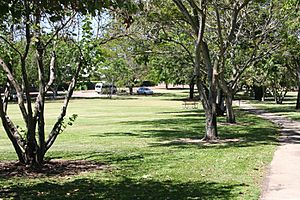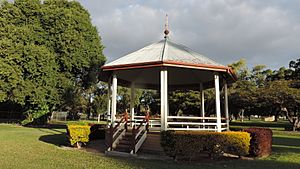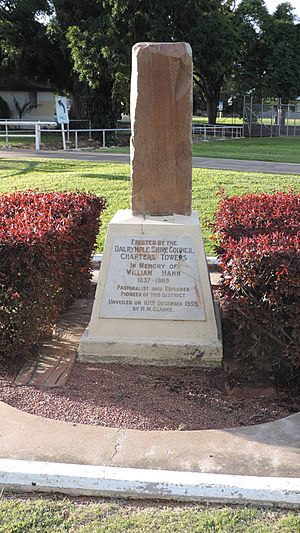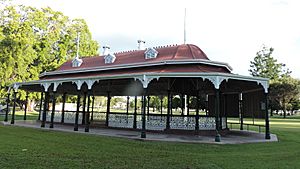Boer War Veterans Memorial Kiosk and Lissner Park facts for kids
Quick facts for kids Boer War Veterans Memorial Kiosk and Lissner Park |
|
|---|---|

Lissner Park, 2009
|
|
| Location | Bridge Street, Charters Towers, Charters Towers Region, Queensland, Australia |
| Design period | 1870s - 1890s (late 19th century) |
| Built | 1883 - 1988 |
| Official name: Boer War Veterans Memorial Kiosk and Lissner Park | |
| Type | state heritage (built, landscape) |
| Designated | 21 October 1992 |
| Reference no. | 600397 |
| Significant period | 1883-(social) 1883-1988(historical) 1883-1959(fabric) |
| Significant components | natural feature - cliff, pond/s - garden, bandstand/rotunda, fountain, memorial - kiosk, fernery, trees/plantings, bridge - foot/pedestrian, enclosure/s - animal, playground, gate/s |
| Lua error in Module:Location_map at line 420: attempt to index field 'wikibase' (a nil value). | |
The Boer War Veterans Memorial Kiosk and Lissner Park is a special heritage-listed park in Charters Towers, Queensland, Australia. It includes a memorial kiosk built to remember soldiers from the Boer War. The park was created between 1883 and 1988. It was added to the Queensland Heritage Register on 21 October 1992 because of its importance to history and the community.
Contents
Discovering Lissner Park's Past
How the Park Began
Lissner Park started as a large area of land set aside for public fun on May 15, 1883. It was named Lissner Park in 1888. This name honored Isidor Lissner, a local businessman and politician from Charters Towers.
Charters Towers became a very rich mining town in North Queensland. But all the mining meant many trees were cut down. People worried about losing the natural environment. Important citizens like Isidor Lissner wanted a park. They believed that parks and gardens helped make communities better.
So, the Charters Towers Municipal Council asked for land to be saved for recreation. The park became a permanent reserve in 1891. The Council became its official caretakers.
Who Was Isidor Lissner?
Isidor Lissner came to Charters Towers in 1873. He built a successful business empire from mining and trade. He cared a lot about his community. He pushed for sports facilities and public places like Lissner Park.
He became a politician in 1883. He worked hard to get better services for Charters Towers. He was also a strong supporter of the North Queensland Separation Movement. This movement wanted North Queensland to become its own state.
Growing the Park
The park received money from the government to help it grow. Early work included clearing land and planting trees. Some of the trees planted back then are still there today. These include tamarinds, figs, and various palm and pine trees.
Fun Times at the Park
People quickly loved having a place for recreation. They built a cricket pitch and enjoyed concerts in the park. As the park became more popular, a special committee was formed. They raised money to build a bandstand.
In 1889, a local architect designed the bandstand. It was octagonal with a large platform for the band. There was also space for dancing or seating. This bandstand became a popular spot for social events.
The park also hosted many celebrations. These included Queen Victoria's Jubilee and events to honor soldiers. It was a central place for the community to gather.
The Boer War Memorial Kiosk
During the Second Boer War, people in Charters Towers raised money to help soldiers and their families. After the war, some money was left over. The local council decided to build a kiosk in Lissner Park. It would be a memorial to the Charters Towers people who served in the war.
In 1909, a competition was held for the best kiosk design. The winning design was slightly changed during building. This was because a floor design of the Australian and Union Jack flags was removed. People felt it was not right to walk on the flags.
The kiosk has an honor board inside. It lists the names of soldiers from the area who died in the Boer War. Over 7,000 people came to the opening ceremony. They enjoyed a concert and saw the bandstand, fountain, and kiosk lit up brightly.
A Place for Protests
Lissner Park also became a place for important meetings. In the late 1880s and early 1890s, many protest meetings were held there. Miners and local people gathered to discuss their rights and working conditions. They talked about issues like mining laws and the need for an eight-hour day. The park was a key spot for people to share their voices and support changes.
Park Features Over Time
Over the years, Lissner Park has changed. A "tin" fountain was installed before 1910. It was later replaced by a new one built by the Lions Club in the 1960s. The original tin fountain has since been returned to the park.
A small lake was built in 1911. Toilets and lighting were also improved. A small zoo was added at one end of the park. However, it is slowly being removed because caring for the animals is expensive. A new, smaller animal area was built in 1988.
In 1959, a memorial was put up for Joseph and William Hann. They were early explorers and cattle farmers in the area. Concrete paths were added in the 1970s.
The park's size was reduced in 1971 when a swimming pool was built. Mosman Creek, which runs through the park, was also lined with concrete and stone.
The Boer War Veterans Memorial Kiosk has been repaired and painted over the years. An irrigation system was installed to water the whole park. This makes it a pleasant place for locals and visitors. Since 2010, many flying foxes have roosted in the park. While some residents dislike them, they are a protected species.
What You See at Lissner Park Today
Exploring Lissner Park
Lissner Park is about 7 hectares (17 acres) in size. It is surrounded by several streets in Charters Towers. The park has lots of grass, trees around its edges, and special structures. These include the Band Rotunda and the Boer War Veterans Memorial Kiosk. The park is mostly flat, rising gently towards Anne Street.
Mosman Creek divides the northern part of the park from the rest. The middle of the park has many of the structures and large, old fig trees. The southern part is grassy and gently sloped. You can find different types of trees here, like figs, jacarandas, and palms.
The Band Rotunda is in the center of the park, near Mosman Creek. It has an eight-sided shape with a pyramid-shaped roof. It is made of timber with decorative iron posts. Palm trees surround the bandstand, and large fig trees are nearby.
Near the bandstand, you can see old wrought iron gates and fence posts.
Further south from the bandstand is what's left of the fountain. It is surrounded by a ring of trees and a small hedge. The fountain is made of folded "tin" sheets.
Other parts of the park include a playground, the 1959 memorial to William Hann, a fernery from 1988, and an animal enclosure from 1988. There's also the Rotary centenary pond from 1972.
Mosman Creek, which crosses the park, is now lined with stone and concrete. Two timber and steel bridges cross the creek. On the other side of the creek, there are two animal enclosures with emus and a kangaroo. The Kennedy Regiment Memorial Swimming Pool is in the north-eastern corner, but it is not part of the park itself.
The Boer War Veterans Memorial Kiosk
The Boer War Veterans Memorial Kiosk stands to the west of the fountain. It is an open structure made of cast iron and steel. Both ends of the kiosk are shaped like a semicircle.
The kiosk has two rings of cast iron columns with fancy tops. These columns hold up the red, bell-shaped roof. The roof has small windows and decorative ironwork.
The outer columns have cast-iron brackets. On one side, there are wooden panels between the columns.
Inside, there's a raised area with another ring of columns. A cast-iron railing runs between these columns. At the western end of the kiosk, behind the wooden panels, is a serving area with marble benches. Above the benches are three marble plaques. They have gilded (gold-colored) letters naming about eighty local soldiers who served in the Boer War. Two cannons face the kiosk at the eastern end.
Why This Place is Important
The Boer War Veterans Memorial Kiosk and Lissner Park were listed on the Queensland Heritage Register in 1992. This means they are very important for several reasons:
- Showing Queensland's History: The Boer War Kiosk, built in 1909, shows how Australians felt patriotic and nationalistic in the early 1900s. It's a memorial that reminds us of how local communities reacted to big events like wars.
- Unique Design: The kiosk is a great example of a memorial from that time. It shows how people honored soldiers and expressed their feelings about war.
- Beautiful Place: Lissner Park still looks like a beautiful Victorian-era park. Many of the original trees planted by Ben Gulliver, a nurseryman and botanist, are still there.
- Community Connection: The park has always been a central place for community events. People have gathered there for celebrations, social activities, and even political meetings. It has a strong connection with the local community.
- Special People: Lissner Park is named after Isidor Lissner, a local businessman and politician. He played a big part in creating the park. The park was developed because people believed that gardens improved society, and Lissner strongly supported this idea.




